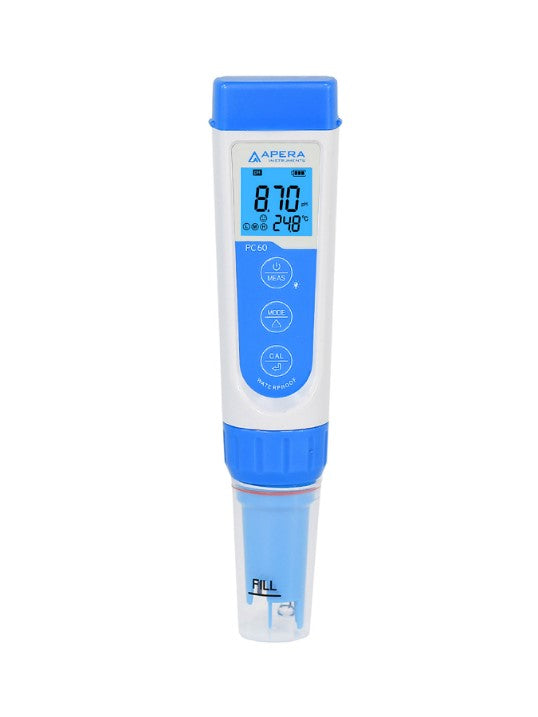Salinity meters are an easy-to-use water quality indicating tool and are a great way to obtain a quick estimate of the dissolved salt present in a wide range of water samples.
They are useful in a wide range of applications from testing salinity levels in water used for agriculture, drinking water, wastewater, and for testing the water in home pools and spas.
If you have an interest in knowing how a salinity meter works, this article is for you.
About Salinity Meters
Salinity Meters are devices that are used to measure the amount of salt present in a substance.
You can purchase salinity meters either on their own or as a sensor in multiparameter meters, which can measure other water quality parameters such as pH, conductivity, TDS and more.
How Salinity Meters Work
The most common way for salinity levels to be measured is through electrical conductivity. Electrical conductivity is the measure of the concentration of ions present within a substance or sample.
You can calculate the ions present within a sample by the substance’s ability to transmit an electrical current over a defined area.Measurement involves the transfer of a current between two electrodes immersed in the substance you wish to test. The more ions present, the more conductive the substance and the higher the electrical conductivity reading will be, the fewer ions present, the less conductive the substance will be.
The measurement unit for electrical conductivity is called Siemens (S). The units display Milli Siemens per centimetre mS/cm or Micro Siemens per cm μS/cm.
The salinity meter’s software will produce a salinity measurement from the electrical conductivity reading by automatically apply a conversion factor. This factor is usually 0.5; however, check device specifications the specific conversion factor used. The conversion factor will take the electrical conductivity measurement and convert it to an estimated salinity measurement, which is displayed in parts per thousand(ppt), parts per million (ppm), grams per litre (g/L) or milligrams per litre (mg/L).
|
Instrument Choice Scientist Tip: The temperature of the substance you are testing for salinity will also impact the results displayed
Make your sampling easier by selecting a salinity meter with automatic temperature compensation (ATC). These devices will adjust results based on actual temperatures, efficiently ensuring quick and accurate readings. |
Salinity Meter Examples
Now you know how salinity meters work, the Instrument Choice Scientists have prepared some examples of salinity meters giving specifications on the salinity units displayed and recommended applications. All examples provided have automatic temperature compensation (ATC).
EC-SaltTestr11 - Waterproof Salt Tester 
The most popular meter for measuring salinity in pools, the EC-SaltTestr11, makes salinity testing a breeze. The large dual display screen shows temperature and accurate salinity levels at the same time.
The device is waterproof, floats on water, and has an easily replaceable sensor.
Applications: We recommended the EC-SaltTestr11 for measuring saltwater pools, ground, wastewater testing, and field studies.
Salinity Unit: ppt
Salinity Range: 0 to 10.00 ppt
ATC: Yes
Parameters: Salinity, Temperature
StarterPen Salinity meter - IC-ST20S 
Simple to use, fast results, and straightforward operation, the IC-ST20S makes for a great water quality tester.
The IP67 rated waterproof housing, study design, and quality construction will provide durable operation in even the toughest saltwater environments.
Applications: Performs well for saltwater pool testing, field use such as testing lakes, streams, and rivers as well as ground and wastewater testing.
Salinity Unit: ppt
Salinity Range: 0.0-80.0ppt
ATC: Yes
Parameters: Salinity, Temperature
PC60 Premium Multiparameter Pocket Tester Kit 
Simultaneously tests pH/EC /TDS /Salinity /Temperature in a quick, accurate, and reliable manner.
The IC-PC60 comes in a kit that includes everything you need to get started, including calibration solutions, calibration bottles, storage solutions, AAA batteries, and a lanyard all in a portable carrying case.
Applications: Instrument Choice customers choose the IC-PC60 for laboratory use, wastewater testing, irrigation water analysis, and drinking water testing.
Salinity Unit: ppt or g/L
Salinity Range: 0 to 10.00 ppt
ATC: Yes
Parameters: Yes – Measures Salinity, pH, EC, TDS, and Temperature.
Conclusion
The inner workings of salinity meters may seem complex, but they produce accurate salinity measurements in a matter of seconds. When looking for a salinity meter, it is important to check whether the units of measurements are suitable for your requirements and choose a device with automatic temperature compensation (ATC) to make measuring faster and easier.
Browse the full range of salinity meters available at Instrument Choice here.
Need help finding the best salinity meter for your needs? Want more information on any of the example meters above? Contact one of our Scientists on 1300 737 871 or email customer-service@instrumentchoice.com.au
